If you’ve come across a penny from 1985, you might be wondering about its history and potential value. Could this seemingly ordinary coin be worth more than just one cent?
You’re in the right place.
In this guide, we’ll dive into everything you need to know about the 1985 Lincoln Memorial penny. From its design and composition to mint varieties and rare errors, you’ll learn what makes some of these coins more valuable than others.
1985 Penny Value Chart (Red Specimens)
| Mint Mark | XF45 | MS60 | MS65 | MS68 |
|---|---|---|---|---|
| 1985 (No Mint Mark) | – | – | $10 | $165 |
| 1985-D | – | – | $10 | $50 |
| Mint Mark | PR60 | PR65 | PR68 | PR70 |
|---|---|---|---|---|
| 1985-S Proof | $1 | $4 | $7 | $225 |
Note: These values apply to red specimens. Red-brown and brown coins are typically worth less.
History of the 1985 Penny

The penny struck in 1985 belongs to the long-running Lincoln cent series, named for the portrait of Abraham Lincoln that appears on the obverse (front) of the coin.
First introduced in 1909 to mark the centennial of Lincoln’s birth, the Lincoln penny became the first U.S. coin to feature a real person. Until then, depicting historical figures—especially presidents—on coins had been avoided, as it was seen as too similar to the monarchies the U.S. had distanced itself from. But with widespread public support and the influence of President Theodore Roosevelt, Lincoln’s image found its way onto the cent.
This decision made history—and the design has remained ever since, making the Lincoln penny the longest-running design in U.S. coinage history.
Changing Reverses Through the Years
While the obverse has stayed the same since 1909, the reverse (back) of the coin has gone through several changes:
- 1909–1958: Featured two wheat ears (known as the “Wheat Penny”).
- 1959–2008: Showed the Lincoln Memorial, marking Lincoln’s 150th birthday. This is the design seen on the 1985 penny.
- 2009: To honor Lincoln’s bicentennial, four special reverses were released—each depicting a different stage of his life.
- 2010–Present: The reverse was updated to the Union Shield design, which symbolizes Lincoln’s role in preserving the Union.
Composition and Weight
The earliest Lincoln pennies were made from bronze (95% copper with tin and zinc). However, rising copper prices made production costly, prompting the Mint to change the composition in 1982.
From 1982 onward—including the 1985 issue—pennies have been made of a zinc core coated with a thin layer of copper. This gives the coin a total weight of 2.5 grams, compared to the heavier 3.11-gram bronze cents minted before the change.
You can even tell them apart by sound:
- Bronze pennies “ping” when dropped on a hard surface.
- Zinc-based pennies (like the 1985 cent) have a duller, plasticky tone.
Features of the 1985 Penny
The Obverse of the 1985 Penny
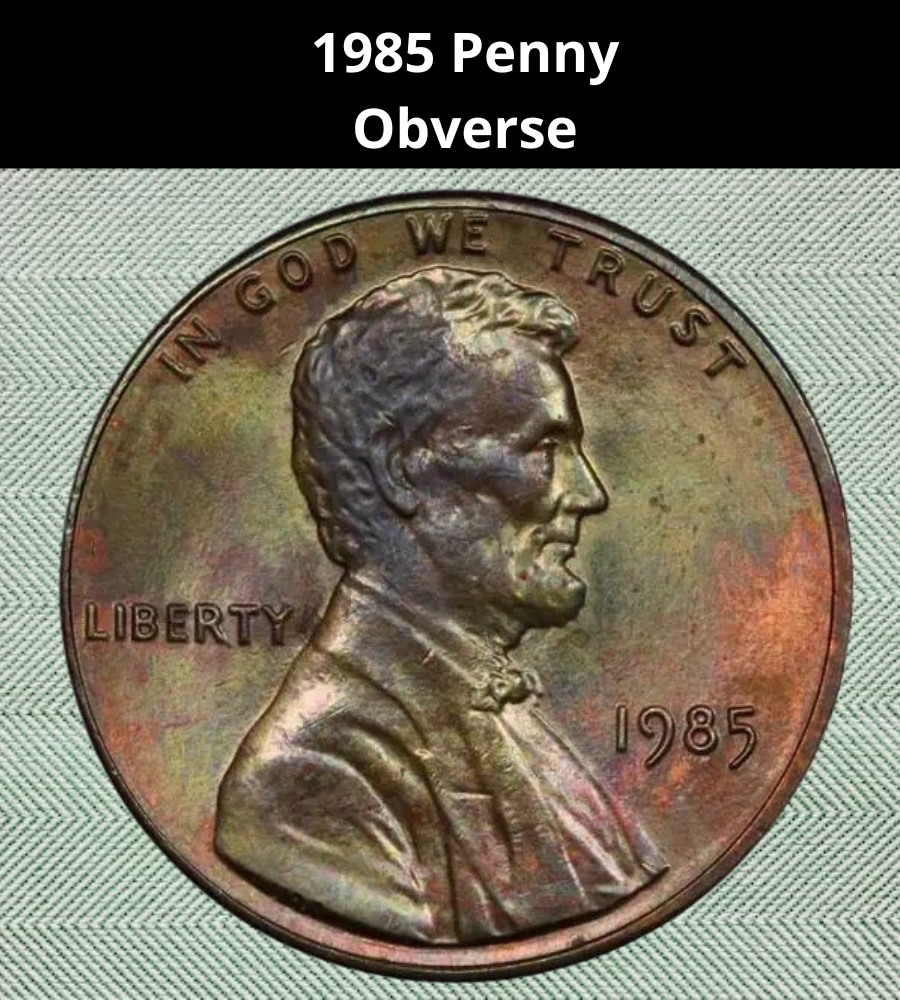
In numismatics, the “obverse” refers to the front or “heads” side of a coin. On the 1985 penny, this side features the iconic image of President Abraham Lincoln, which is why it’s often affectionately called the “Lincoln penny.”
The portrait was designed by Victor David Brenner, a Lithuanian-born artist who emigrated to the United States in 1890. Brenner came from a family of metalworkers and began learning the craft of decorative metalwork at a young age.
Although the exact circumstances of how he was chosen to design the penny remain uncertain, there is a compelling theory. Brenner had previously sculpted a likeness of President Theodore Roosevelt for a commemorative medal. Given Roosevelt’s personal involvement in revamping American coinage and his advocacy for honoring Lincoln on the cent, it’s likely that he had a role in Brenner’s selection.
Brenner’s right-facing profile of Lincoln captures the President in a thoughtful, human moment. He later remarked that he imagined Lincoln as he might look while reading to a child, portraying him as warm and animated.
You’ll find Brenner’s initials “V.D.B.” subtly placed at the base of Lincoln’s shoulder on the obverse.
Other familiar inscriptions include:
- “IN GOD WE TRUST” arched along the top rim,
- “LIBERTY” to the left of Lincoln’s portrait,
- The date “1985” to the lower right,
- And if the coin has a mint mark (such as “D” for Denver or “S” for San Francisco), it will appear just beneath the date.
The Reverse of the 1985 Penny
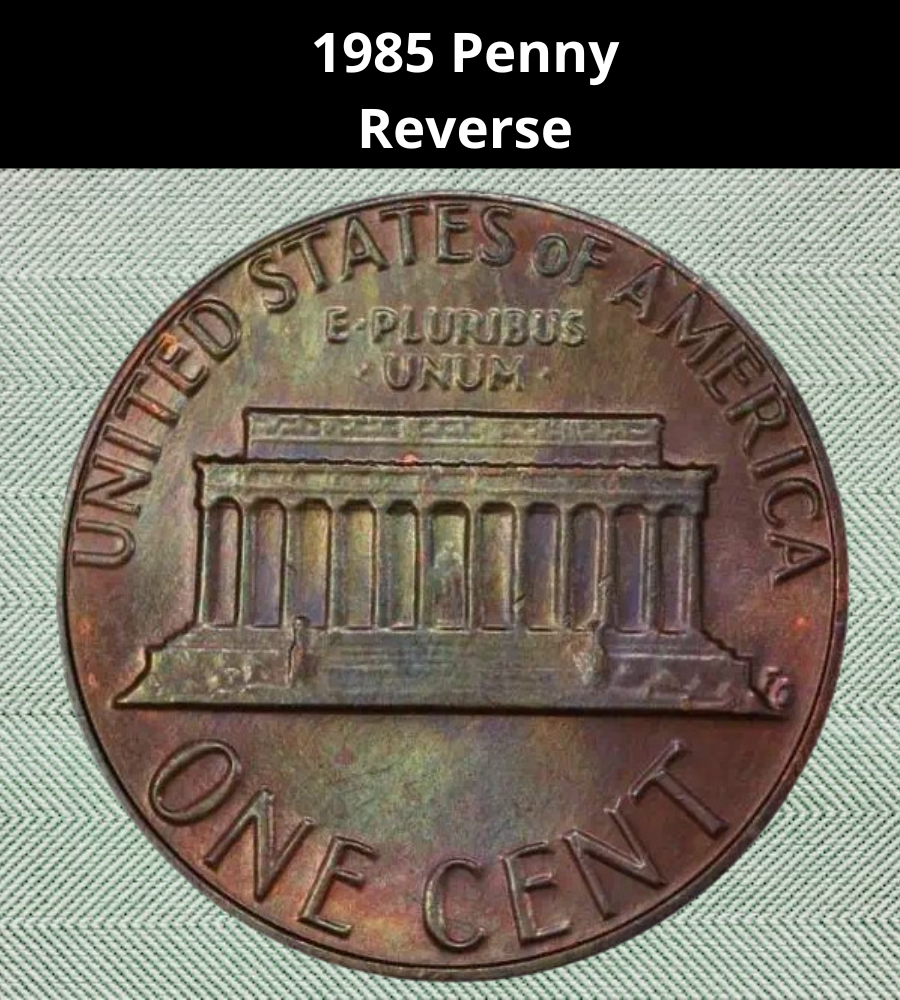
The reverse of the 1985 penny showcases the iconic Lincoln Memorial, a neoclassical building located in Washington, D.C. Look closely at the center of the portico, and you’ll see something remarkable—a tiny engraving of the seated statue of Lincoln. This subtle inclusion makes the Lincoln penny one of the few U.S. coins to feature the same person on both sides.
This design was introduced in 1959 to commemorate the 150th anniversary of Abraham Lincoln’s birth and remained in use until 2008. The artwork was created by Frank Gasparro, who served as the U.S. Mint’s Chief Engraver. His initials, “FG,” are etched to the right of the memorial, just beside the base of the steps.
Additional design elements include:
- The legend “UNITED STATES OF AMERICA” arched along the top rim,
- The motto “E PLURIBUS UNUM” just beneath it, Latin for “From the many, one,”
- And the denomination, “ONE CENT,” in bold lettering along the bottom edge.
Other Features of the 1985 Penny
By 1985, the penny had transitioned to a new composition: a zinc core with a thin copper plating. This change was made in 1982 due to rising copper prices, and it remains the standard composition today.
Because of its copper coating, the color of the 1985 penny can vary greatly depending on its condition and exposure to the environment. These color variations affect both a coin’s appearance and value.
Lincoln cents are categorized into three color designations:
- Red (RD): At least 95% of the surface retains its original red mint luster. These are the most desirable and valuable.
- Red and Brown (RB): A mix of red and brown tones, with 5%–95% red.
- Brown (BN): At least 95% of the coin has turned brown from oxidation or circulation wear. These are the least valuable.
👉 Want to learn how to determine your coin’s color grade? Check out this YouTube video by Len Here for a practical visual guide on color grading Lincoln cents.
1985 Penny Grading Guide
Grading is a crucial step in determining your coin’s true value. It reflects the condition of the penny and significantly impacts its market price. Below is a simplified breakdown of coin grades commonly used for Lincoln cents like the 1985 penny:
| Grade Number | Grade Name | Description |
|---|---|---|
| 1 | Basal State-1 | Nearly unrecognizable; heavy wear with barely any details visible. |
| 2 | Fair | Extremely worn, but the outline of Lincoln is still distinguishable. |
| 3 | Very Fair | More defined than Fair; still heavy wear throughout. |
| 4–6 | Good (G) | Major features are outlined but heavily worn; date may be weak. |
| 7–10 | Very Good (VG) | Design is visible with moderate to heavy wear. |
| 12, 15 | Fine (F) | Moderate wear; more details visible on Lincoln’s face and clothing. |
| 20, 30 | Very Fine (VF) | Moderate wear on high points; sharper details are evident. |
| 40 | Extremely Fine (EF or XF) | Light wear on only the highest points; most details remain sharp. |
| 50 | About Uncirculated (AU) | Traces of wear on the highest points; coin retains much of its original luster. |
| 60 | Mint State (MS60) | Uncirculated but may have noticeable contact marks or dullness. |
| 65 | Mint State (MS65) | High-quality uncirculated coin; few marks, strong luster. |
| 70 | Mint State (MS70) | Perfect coin with no visible flaws under magnification; exceptional strike and eye appeal. |
✅ Tip: When evaluating your coin, pay close attention to high points such as Lincoln’s jawline, hair, and the bowtie, as well as the steps and columns of the Lincoln Memorial on the reverse.
1985 Penny Value Guides
1985 No Mint Mark Penny Value
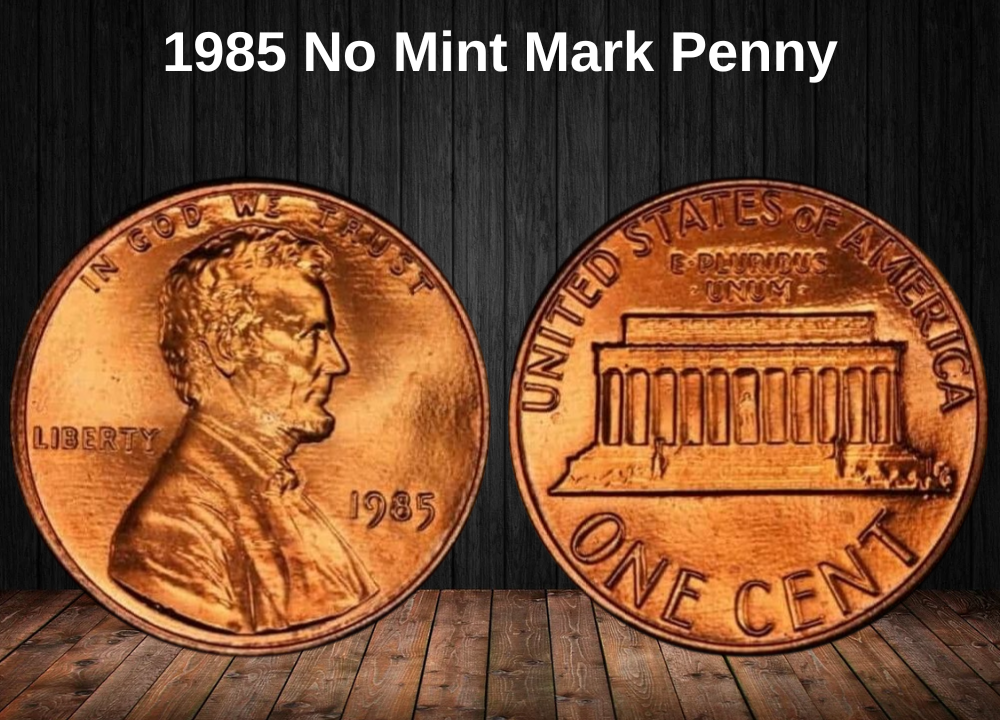
During the 1980s, Lincoln pennies were produced in huge numbers, and 1985 was no exception. That year, the Philadelphia Mint struck more than 5.6 billion pennies.
How to Identify a Philadelphia Penny
To determine where your coin was minted, look at the date on the obverse (heads side).
- A “D” indicates it was made in Denver.
- An “S” means it came from the San Francisco Mint.
- If there’s no mint mark, it was struck in Philadelphia.
Availability and Rarity
Despite the passage of time, 1985 Philadelphia pennies remain easy to find because of their massive production. Unless your coin features a rare mint error, examples with a brown or red-brown tone and circulated wear typically hold no premium over face value.
Value in Higher Grades
However, uncirculated red examples — those that have never entered circulation — can be worth more, particularly in top condition. The better the grade, the more valuable the coin becomes.
| Grade | Color | Estimated Value |
|---|---|---|
| MS60 | Red | ~$1 |
| MS65 (Gem) | Red | ~$10 |
| MS67 | Red | ~$30 |
| MS68 | Red | ~$165 |
| MS68+ | Red | ~$3,750 |
| MS69 | Red | ~$15,500 |
Collector Insight
The independent grading service PCGS has certified only twelve coins at MS68+, and just one coin has ever received a grade of MS69, making it the finest known example. That single MS69 penny is valued at an impressive $15,500.
If you believe your 1985 penny is in exceptional condition, it may be worth having it graded professionally. Mint State coins graded MS68 or above are rare and highly collectible.
1985 D Penny Value
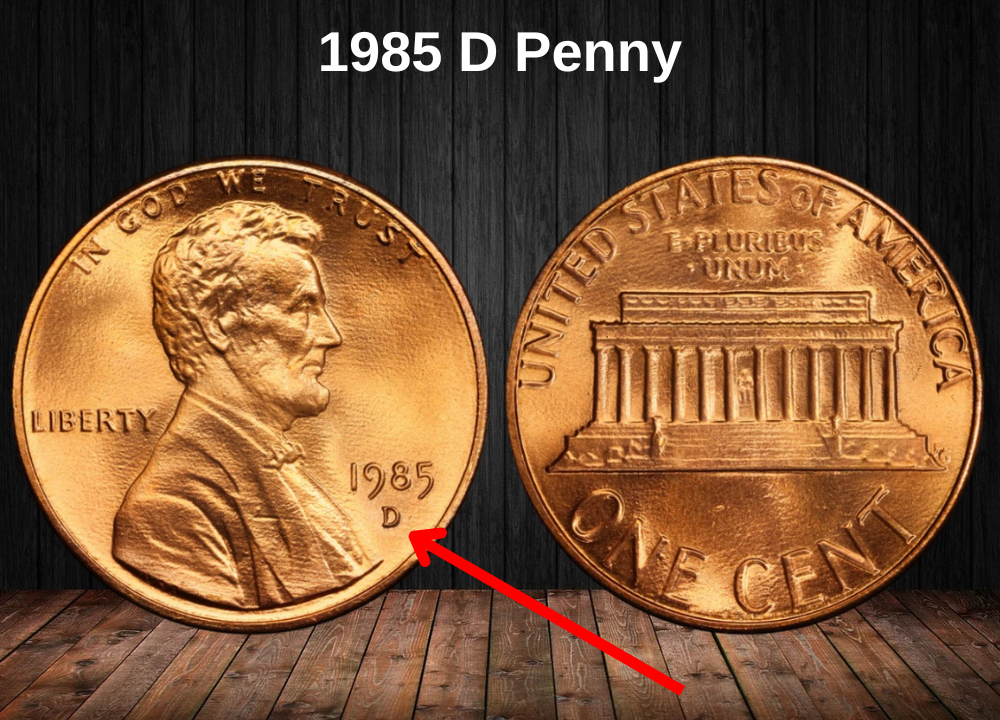
The Denver Mint was just as active as Philadelphia in 1985, producing over 5.2 billion Lincoln pennies that year.
Typical Value and Collectibility
For most circulated coins from this mintage, especially those with brown or red-brown coloring, the value remains at or near face value. Even red, uncirculated examples generally begin at about $1.
When it comes to higher grades, the values start to increase.
- A red specimen graded MS65 is typically worth around $10.
- At MS68, that value climbs to about $50.
Top-Grade Examples
The best-known 1985-D pennies have been graded MS69 by the PCGS. So far, eleven coins have received this grade — a higher number than their Philadelphia counterparts. As a result, while still considered rare, their market price is somewhat lower.
A 1985-D penny graded MS69 is currently valued at approximately $2,600, making it a more affordable top-grade option for serious collectors compared to the Philadelphia MS69 penny.
1985 S Proof Penny Value
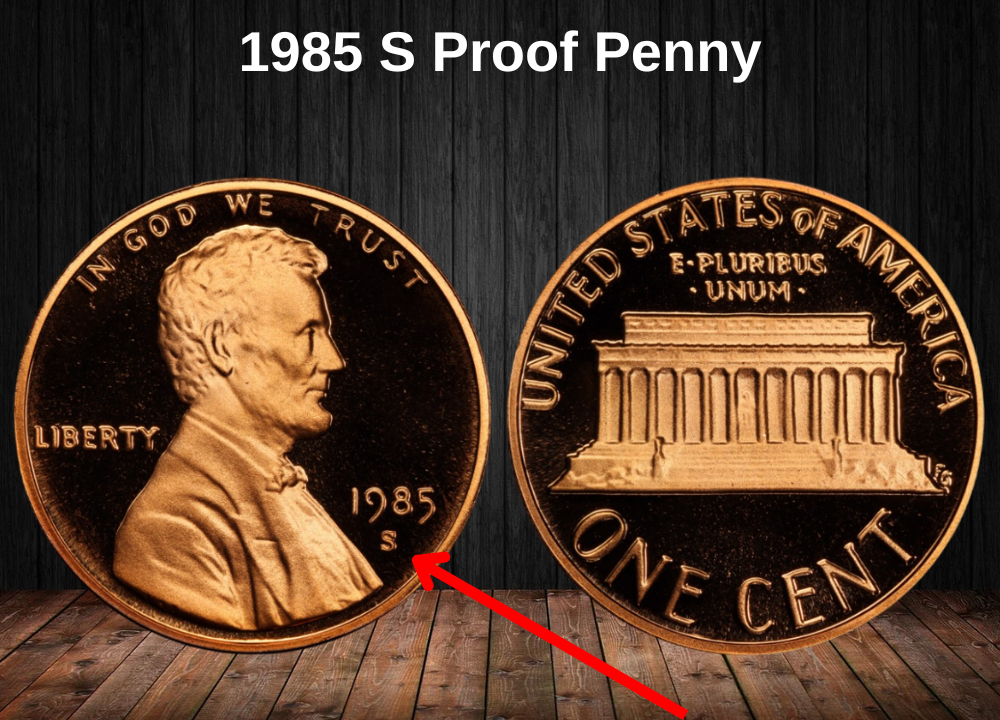
In 1985, the San Francisco Mint produced just over 3 million pennies bearing the “S” mint mark. Unlike the Philadelphia and Denver issues, these coins were not intended for general circulation. Instead, they were proof coins—crafted using specially prepared dies and planchets specifically for collectors.
Since they were always regarded as collector’s items, most proof pennies were carefully stored, which is why many remain in excellent condition today.
Proof coins rarely appear in grades below PR60. A 1985-S penny graded PR60 is valued by the PCGS at approximately $1, with that price remaining steady through PR62+.
A gem-quality PR65 proof is valued at around $4, while a nearly perfect PR69 coin fetches roughly $14.
Rare 1985 Penny Errors List
1985 (P) No Mint Mark Penny, Large Cud Die Break
Dies endure a lot of pressure as they imprint designs onto millions of planchets. Occasionally, a portion of the die can break off, causing a missing or blank area on the coins produced.
This exact issue occurred with a 1985 penny struck at the Philadelphia Mint. The damage to the reverse die caused the omission of the word “CENT” and the bottom right section of the Lincoln Memorial. Additionally, the obverse displayed a flattened spot over Lincoln’s forehead.
This coin was graded MS64 red and brown by the PCGS. When it went to auction, it fetched a price of $455.
1985 (P) No Mint Mark Penny, Partial Plating
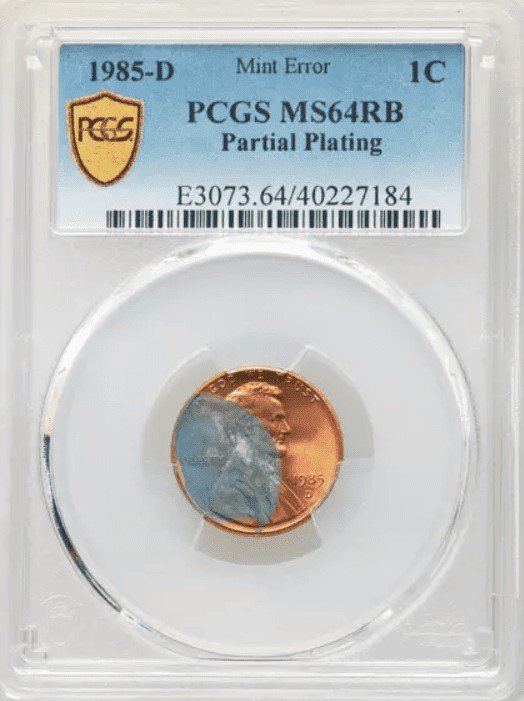
From 1982 onwards, pennies were made with a zinc core clad in copper. However, the cladding process didn’t always work perfectly, leading to a category of error coins called partial plating errors.
In these coins, part of the zinc core is visible alongside areas still covered with copper cladding, creating a two-tone coloration that is unusual, attractive, and collectible.
A 1985 Philadelphia penny with partial plating showed grey zinc visible over Lincoln’s head and lapel, while the rest of the obverse retained its copper cladding. On the reverse, the error was subtler: a line of grey zinc running diagonally through the Lincoln Memorial.
This coin was graded MS64 red and brown by the PCGS and sold at auction for $550.
There is a YouTube video from Couch Collectibles that features a variety of 1985 coin errors, including those on Lincoln pennies.
Where to sell your penny?
Now that you know the value of your penny, you might be wondering where to sell it. Don’t worry: here’s a guide to some of the best online platforms where you can easily sell your coins, along with their advantages and disadvantages.
Discover the best platforms for selling coins online (pros and cons).
FAQ about the 1985 Penny
1. How did economic and metal market conditions in 1985 influence the production of the penny?
In 1985, the copper-plated zinc penny was firmly established due to the high price of copper. The U.S. Mint’s decision to continue this composition was shaped by metal market volatility, aiming to balance cost and durability. This year also saw refinements in planchet quality to reduce defects and improve strike consistency.
2. Are there any subtle die variations or minting anomalies unique to 1985 pennies that could affect collector value?
Yes. Beyond well-known doubled dies, 1985 pennies exhibit several minor die cracks, die chips, and repunched mint marks (RPMs)—especially on Denver (D) mint issues. These subtle varieties often go unnoticed but can command premiums in high grades.
3. Why is the 1985 penny considered less prone to post-mint damage compared to early 1980s issues?
The Mint improved metal plating processes in 1985, resulting in pennies with better corrosion resistance and surface durability. This means 1985 pennies often retain original luster longer than earlier copper-plated zinc cents, which had issues with plating flaking.
4. How can one distinguish an authentic 1985 doubled die obverse penny from a mechanical or digitally altered fake?
Authentic doubled die obverses show consistent, raised doubling on the die itself, especially on the date and “LIBERTY.” Careful examination under magnification reveals uniform raised edges, unlike digital fakes which lack texture or mechanical tooling marks inconsistent with die doubling.
5. What role do toning patterns play in the value and collectability of 1985 pennies?
Toning, especially natural rainbow or iridescent hues developed over decades, increases desirability and value for 1985 pennies. Collectors prize coins with vibrant, even toning that highlights details without obscuring them. Artificial toning is easily spotted and typically reduces value.
6. Are there any documented off-metal errors for the 1985 penny, and how rare are they?
Off-metal errors for 1985 pennies—such as coins struck on bronze or steel planchets—are exceedingly rare but have been reported. Such coins are prized anomalies and can fetch thousands of dollars, but must be authenticated due to potential counterfeiting.
7. How did technological advances in minting equipment by 1985 affect penny production quality compared to previous years?
By 1985, the U.S. Mint integrated more automated quality control and precision die-making techniques, resulting in fewer strike errors and more consistent details. These advances contributed to sharper design elements and reduced die wear, making 1985 pennies generally higher quality than many 1980s predecessors.


















































